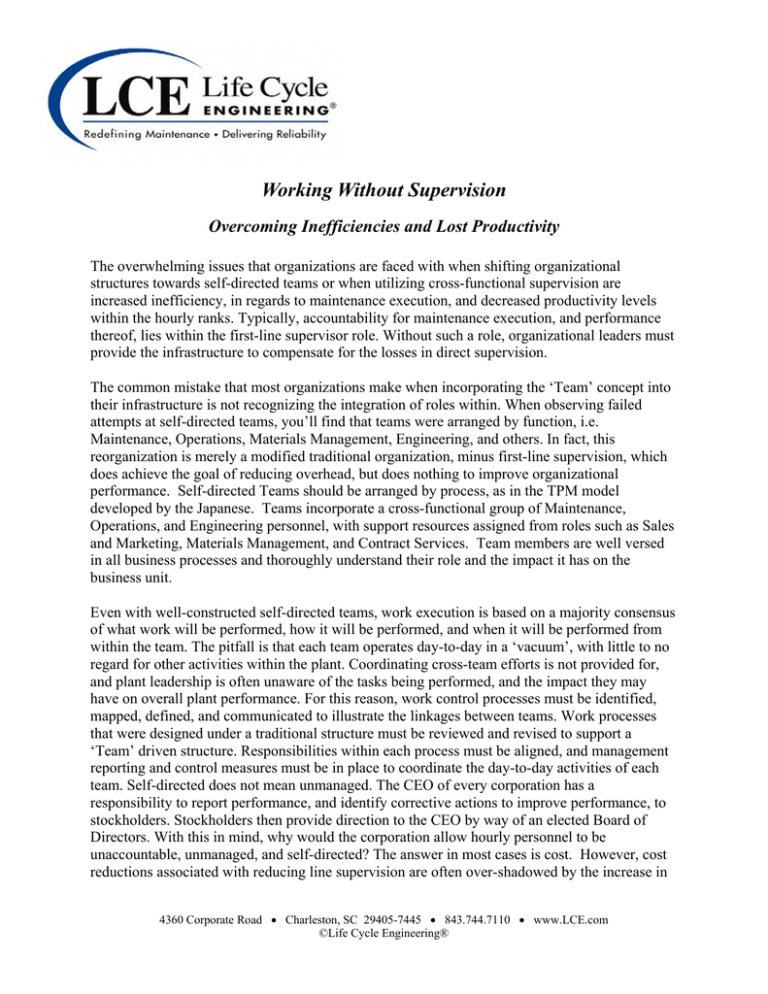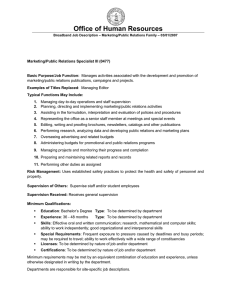Working Without Supervision Overcoming Inefficiencies and Lost Productivity
advertisement

Working Without Supervision Overcoming Inefficiencies and Lost Productivity The overwhelming issues that organizations are faced with when shifting organizational structures towards self-directed teams or when utilizing cross-functional supervision are increased inefficiency, in regards to maintenance execution, and decreased productivity levels within the hourly ranks. Typically, accountability for maintenance execution, and performance thereof, lies within the first-line supervisor role. Without such a role, organizational leaders must provide the infrastructure to compensate for the losses in direct supervision. The common mistake that most organizations make when incorporating the ‘Team’ concept into their infrastructure is not recognizing the integration of roles within. When observing failed attempts at self-directed teams, you’ll find that teams were arranged by function, i.e. Maintenance, Operations, Materials Management, Engineering, and others. In fact, this reorganization is merely a modified traditional organization, minus first-line supervision, which does achieve the goal of reducing overhead, but does nothing to improve organizational performance. Self-directed Teams should be arranged by process, as in the TPM model developed by the Japanese. Teams incorporate a cross-functional group of Maintenance, Operations, and Engineering personnel, with support resources assigned from roles such as Sales and Marketing, Materials Management, and Contract Services. Team members are well versed in all business processes and thoroughly understand their role and the impact it has on the business unit. Even with well-constructed self-directed teams, work execution is based on a majority consensus of what work will be performed, how it will be performed, and when it will be performed from within the team. The pitfall is that each team operates day-to-day in a ‘vacuum’, with little to no regard for other activities within the plant. Coordinating cross-team efforts is not provided for, and plant leadership is often unaware of the tasks being performed, and the impact they may have on overall plant performance. For this reason, work control processes must be identified, mapped, defined, and communicated to illustrate the linkages between teams. Work processes that were designed under a traditional structure must be reviewed and revised to support a ‘Team’ driven structure. Responsibilities within each process must be aligned, and management reporting and control measures must be in place to coordinate the day-to-day activities of each team. Self-directed does not mean unmanaged. The CEO of every corporation has a responsibility to report performance, and identify corrective actions to improve performance, to stockholders. Stockholders then provide direction to the CEO by way of an elected Board of Directors. With this in mind, why would the corporation allow hourly personnel to be unaccountable, unmanaged, and self-directed? The answer in most cases is cost. However, cost reductions associated with reducing line supervision are often over-shadowed by the increase in 4360 Corporate Road • Charleston, SC 29405-7445 • 843.744.7110 • www.LCE.com ©Life Cycle Engineering® maintenance and operating costs, as a result of less reliable equipment, caused by inefficiencies in the work processes and decreasing productivity of maintenance crews. Overcoming Inefficiencies and Lost Productivity Organizations who are looking to restructure in order to cut overhead costs need to first prepare the organization for change. Successful and effective use of self-directed teams requires a high level of discipline and motivation. Team members will be required to step outside their traditional roles, accept new responsibilities, and work cooperatively with those members of the organization who have always been ‘them’. This level of cooperation must be evident at the plant leadership level, portrayed in their actions as a common goal and unified commitment. When considering self-direct teams or cross-functional supervision, examine your current work control processes to ensure the direction required to support Best Practices is maintained without the presence of first-line supervision. Work control processes exist in every organization, such as, Maintenance, Reliability Engineering, Materials Management, Operations, and Sales and Marketing. Although each process is independently defined, all work control processes should be fully integrated to sustain and improve overall plant performance. To ensure the proper level of direction, identify the critical steps within each process that require higher levels of coordination, approval, recognition, and control. Develop your organizational structure utilizing the work control processes as a guide to assembling the functional aspects of each ‘Team’. Determine the type of work and quantity to be performed and allocate resources to each team as appropriate. Periodically review the volume of work performed and the volume of work requested, for each team, to align manpower with the operating needs of the plant. Utilize cross-functional supervisors at the highest level necessary to oversee the critical steps within each process for a given boundary, while maintaining accountability within each at the lowest possible level. For example, the Scheduling and Coordination Meeting is a critical step within the Scheduling process, as it requires input and direction from all process areas, functional roles, and work teams within the plant to ensure plant performance is optimized. The managing member for the planning and scheduling function would oversee this step, however, accountability is assigned to the planning and scheduling coordinator in each team. Empower team members with the knowledge and understanding of plant policies, procedures, and business philosophies through programmed training and evaluation. Those organizations that have successfully reduced first-line supervision have embraced the need for cross-training personnel. The efficiency of each process demands that every member be capable of executing each step of the process, consistently. When everyone understands the affects of not following the process as defined, the need for direct supervision is diminished. Once the work control processes are developed to close the gaps caused by the absence of line supervision, Key Performance Indicators (KPI) should be defined and implemented to measure process compliance and the performance of each team. Additionally, these KPIs should be monitored to identify opportunities to eliminate the inherent process inefficiencies. 4360 Corporate Road • Charleston, SC 29405-7445 • 843.744.7110 • www.LCE.com ©Life Cycle Engineering® In conclusion, removing the piece of infrastructure that has served as the “director” of work execution for so many years will have devastating affects on the productivity of work crews and will allow for greater inefficiencies throughout the plant. Providing direction through definitive process controls, coupled with the integration of functional roles within the organization will add to the success of the restructuring effort and will ensure the sustainability of plant performance. For more information please contact Life Cycle Engineering at 843-744-7110, or visit our website at www.lce.com. 4360 Corporate Road • Charleston, SC 29405-7445 • 843.744.7110 • www.LCE.com ©Life Cycle Engineering®






